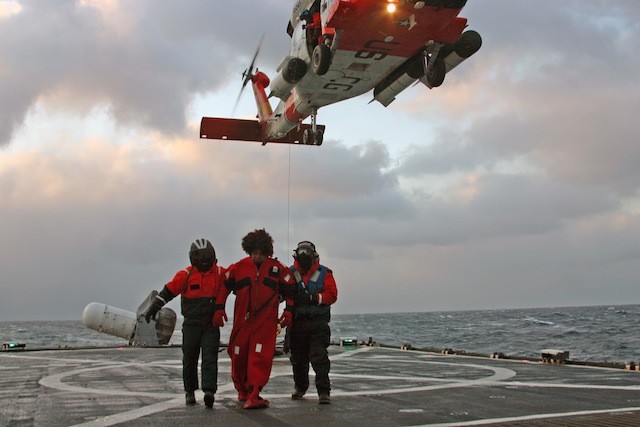–Editor’s Note: The following article has been submitted to gCaptain for re-publication by the Coast Guard Compass, the official blog of the U.S.C.G.–
After the rescue of 42 crewmembers from the fishing vessel Alaska Ranger in 2008, author Kalee Thompson produced an in-depth report on one of the most challenging missions in Coast Guard history. She went on to write a book that examined the sinking, the rescue and the fishing industry. We asked for her thoughts on the recently released report of the Marine Board of Investigation since few have examined the case to the extent she has. All opinions expressed by Ms. Thompson are her own and posting her perspective in no way reflects the opinion of the United States Coast Guard.

Photo: A crew member of the Alaska Ranger is taken on board the Coast Guard Cutter Munro. The Alaska Ranger began taking on water 120 miles west of Dutch Harbor. (U.S. Coast Guard Photo by CGC Munro)
Guest post by Kalee Thompson
When the bottom trawler Alaska Ranger foundered and sank in the Bering Sea in March 2008 the Coast Guard was ready. The 189-foot fishing vessel began taking on water around 2:20 a.m. on Easter morning. By 4:30, all 47 people on board had abandoned ship. More than half of them failed to get into life rafts. The first Coast Guard rescue asset-an HH-60 Jayhawk, forward deployed to remote St. Paul Island-arrived on scene at 5:00 a.m. and eventually plucked sixteen fishermen from the waves. More men were saved by the crew of an HH-65 Dolphin while a Kodiak C-130 flew cover and provided a communications platform for the rescuers below.
Dozens of Coasties ultimately contributed to the rescue effort and their work paid off: against all odds, 42 of the 47 crew of the Alaska Ranger were recovered alive from dark, 32Ëš seas, twenty of them individually pulled from breaking swells by Coast Guard helicopters and then carefully lowered to the flight deck of the Coast Guard Cutter Munro. In terms of the number of people airlifted directly from the ocean, the rescue was unprecedented in Coast Guard history.
I originally reported on the Alaska Ranger case for Popular Mechanics Magazine and in 2010 published a nonfiction book, Deadliest Sea, on the disaster. From the start, it was obvious that much went right on that Easter morning-which is what makes the story both compelling and inspirational. But within a day of the disaster a team of Coast Guard investigators was tasked with investigating what went wrong. Their comprehensive report was released this week.
One veteran Coast Guard officer explained to me early on in my reporting that casualty investigations can be like peeling an onion. “There’s a limit to how far you can go,” he told me. “You never get to the core.” I was surprised to discover, for instance, that the marine board would not be considering past marine casualties involving the Fishing Company of Alaska, the company that owned the ship. To me, those events seemed entirely relevant to the poor safety culture witnessed onboard the Alaska Ranger. I was also disappointed that the board declined to call the company’s owner, Karena Adler, to testify. In the end, it feels like a company that put profit over safety time and again got off with little more than a slap on the wrist.
The MBI report is much harder on the Coast Guard’s own. The final report devotes dozens of pages to evaluating the multiple shortcomings of the regional ACSA program (Alternative Compliance and Safety Agreement) that governs the Bering Sea Head and Gut fleet and includes several suggestions for how helicopter rescuers might avoid future mishaps like the one that occurred when a hypothermic Alaska Ranger fishermen fell from a rescue basket during a hoist.
During the course of my book research, I spent time with Coast Guard fishing vessel inspectors in both Washington State and Alaska and found them to be deeply committed to their safety mission. But for years they have been fighting an uphill battle against a regulatory environment that protects the financial interests of industry over the safety of fishermen.
Unfortunately, it sometimes takes egregious tragedies to energize public–and Congressional–support for stiffer regulation. New safety standards– like those included in the recently passed Coast Guard Authorization Act — are crucial to providing the Coast Guard with the power to demand and enforce safer conditions in the commercial fishing industry. I hope these new laws will be accompanied soon with funding for more inspectors and resources. Hard-working Coasties and the fishermen they protect deserve nothing less.
Kalee Thompson is a contributing editor at Popular Mechanics Magazine and the author of the book Deadliest Sea: The Untold Story Behind the Greatest Rescue in Coast Guard History.

 Join The Club
Join The Club











